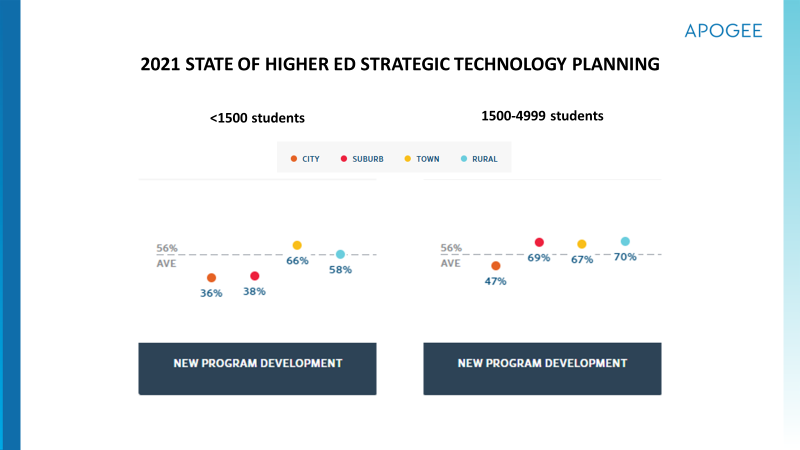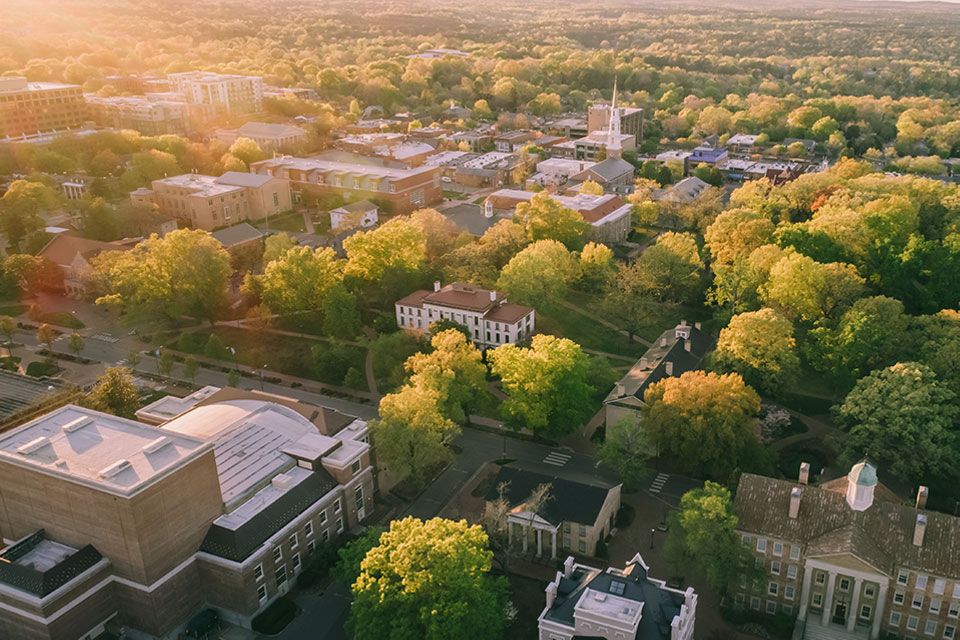It’s that time of year again – prediction time! These prediction posts are fun to pull together because we can take a step back and think about the future and play pundit for a bit. My colleague Matt Loecke and I made 10 predictions for higher ed last year, and we were grinning when we saw that we got 8 of them right, or, er, almost right.
Higher education is still dealing with the fallout from the pandemic that doesn’t seem to end. Highly available and effective vaccines are here, 201 million Americans (or 61%) are fully vaccinated, but a new “omicron” coronavirus variant combined with inflation threaten higher ed. Apogee believes technology is central to reimagining and strengthening higher education to weather pandemics, economic downturns, and gaps in job readiness. We’re committed to helping our customers leverage managed technology services to unlock the time needed to focus on their teaching and learning missions.
It’s with that lens that Matt and I share our top ten predictions for higher education in 2022:
- The Great Resignation will persist, and staffing will be a key concern in 2022. A record 4.4 million Americans quit their job in September 2021 and another 4.2 million people quit in October 2021, according to the Bureau of Labor Statistics, some to take different jobs and some to leave the labor pool altogether. So, people are looking for new jobs, and they’re also actively leaving the workforce. Most of us have experienced the labor shortage as consumers: long waits in restaurants, poor service wherever we go, and packages that aren’t delivered on time. Higher ed isn’t used to battling high turnover rates or struggling to attract and retain talented professionals. But current labor market conditions are creating challenges never experienced before, especially in rural areas and in an industry that tends to offer pay below the private sector. This is creating an IT pro gap at institutions that need to deploy and maintain technologies that modernize campuses to attract, retain, and graduate successful students.This is clearly a job seeker’s market. The labor shortage creates a situation where workers can jump from job to job as they chase higher wages, better benefits, better work/life balance, an employer that’s highly focused on social issues, and other things a person might value in their job environment. And if your IT team is feeling burnout, a fatter paycheck won’t keep knowledge workers from leaving. Now is the time to consider managed technology services to get some relief.
- The number of colleges and universities will continue to shrink due to closure and consolidation. IPEDS just released its latest data on the number of institutions eligible to award federal financial aid. The total number fell from 6,145 schools in 2019-2020 to 6,063 schools in the just completed 2020-21 academic year. Closures of for-profit colleges and universities accounted for about three-quarters of the 579 institutions that disappeared, but in that same period, the number of public four-year universities declined by 2.3 percent to 773, the number of private four-year universities declined by .8 percent to 1608, and the number of community colleges dropped by 2.7 percent to 920. The huge influx of federal funds through CARES and the American Rescue Plan likely saved many institutions from failure, but we expect that the pace of closures or mergers will increase as the impact of the funds fade.
- New program/curriculum development will become a top priority. Gen Z is demanding immediate ROI from their higher education investment and a blended learning experience. Institutions will continue to phase out programs that don’t add value and add new and modern programs, many online, to meet Gen Z demands for job readiness and affordability. Our analysis of 891 institutional strategic plans bears this out. In 2020, just 39% of higher ed strategic plans listed New Program Development as a pedagogical initiative. That number has jumped to 56% in 2021, with schools in towns and rural areas leading the charge.

- There will be a Residence Hall Renaissance in smaller colleges and universities. We predict that smaller schools will double-down on their investments in the residence hall experience to deliver the unique on-campus experience that can be such a differentiator for smaller, private schools in rural or town areas. In an essay published in The Chronicle of Higher Education, co-authors Arthur Levine and Scott Van Pelt outlined five “profound and jarring new realities” shaping the future of higher education.While each of these trends – the result of conversations with college presidents, higher ed associations, and policymakers – are broadly relevant for school administrators, one trend stands out among the rest: “With near universal access to digital devices and the internet, students will seek from higher education the same things they are getting from the music, movie, and newspaper industries.” The commonality among these three industries is apparent: Each has developed options for on-demand, unbundled access in response to consumer wants and needs (think buying a song on the go rather than the entire album from a fixed location). Digital natives prefer anytime, anyplace access. Service, quality, affordability, and only being charged for services they use, are natural outcroppings of this preference. This trend reinforces the idea that Gen Z expectations are rooted in connectivity, or, at the very least, in the things that connectivity enables. In the context of their consumer preferences, a personalized experience and greater flexibility and control are obvious wants. Communication, collaboration, and a sense of community round out the list. All together, these connectivity-enabled benefits are the foundation of a compelling on-campus residential experience. Check out our e-book (PDF) that dives into greater detail on how we can partner with you to enable this residence hall renaissance.
- Higher ed “go-it-alone” behavior will finally end. At Apogee, we believe that colleges and universities thrive when they focus on teaching, learning, and building a connected campus community. So much time, effort, resources, and headspace are taken up when institutions do things outside their wheelhouse and do them unaided. Higher ed will turn to technology partners, shared services, and consortia for help to get costs down and to free up the thinkers and innovators within their organizations to focus on strategic priorities. 2022 and beyond will see more shared programs, systems, faculty, and students among public systems, reconfigured programs, regional partnerships, and private partnerships.
- Diversity, Equity, and Inclusion programs will continue to get resources and attention. This is another area that showed significant movement in our strategic planning interactive report. In 2020, only 9 percent of the strategic plans in our study called out DEI initiatives in their Planning and Governance. In 2021, that number jumped to 24 percent, with institutions in cities and suburbs leading the charge with 48 percent and 52 percent having documented DEI initiatives, respectively, compared to 13 percent each in schools in rural and town areas. Larger population centers have moved more quickly to ensure these programs are built into an institution’s governance model, and we predict that these important initiatives will continue to get the attention they need.
- Schools of all sizes will double down on cybersecurity. Recent research indicates that colleges and universities rank third for data breaches, and a 2021 Education Cybersecurity Report indicated that data breaches were the main source of risk for higher education institutions. With more institutions putting off modernizing old processes and more students using more devices on campus classrooms, the risk is growing. Having a modern and stable IT infrastructure that is continually refreshed, future-proofed, and protected will be a requirement that higher ed establishes in 2022 to reduce or eliminate the threat of data breaches.
- Higher ed will play an important role in developing and implementing states’ digital equity plans. In November, President Biden signed the $1.2 trillion bipartisan infrastructure billinto law, paving the way for much-needed funding for everything from roads and bridges to expanding ports and airport capacity to upgrading electrical grids. A small but important sliver of the infrastructure bill could also be a salve to the digital divide. The Commerce Department is charged with dispersing approximately $42 billion in funding from the infrastructure package to states to ensure all Americans have access to affordable, high-speed broadband internet. That includes providing at least $100 million in grants.Where broadband is available, it promises another $14.2 billion to create a permanent $30-a-month-subsidy program to help low-income Americans afford service. The bill offers an additional $2.75 billion for digital equity and inclusion efforts, which could end digital redlining, the practice of internet service providers avoiding lower-income areas – typically, neighborhoods with large populations of people of color — where they don’t think they’ll make money. Colleges and universities will be in the running for competitive grants to facilitate the development and delivery of services and resources to expand community awareness about making effective use of the newly available broadband.
- “Small and Scrappy Schools” will innovate faster via technology partnerships. There is a segment of private not-for-profit institutions with enrollment under 1500 students that have administrators and staff so committed to student success that they do wonders with their limited resources and time. We affectionately call these customers “small and scrappy.” We predict that these institutions will thrive in the next three years because their leadership teams are committed to innovation, to sustainable change, and to partnering for technology solutions and services that free them up to move faster on innovations in pedagogy and student services. Check out our stories to learn more about schools like Lyon College, Centenary College, and Saint Augustine’s University.
- We can’t call it on the community college conundrum. Community colleges play a critical role in providing local access to higher education across the US. That’s why the continuing enrollment declines in community colleges are so alarming. After the worst enrollment drop in a decade, colleges hoped COVID-19 vaccinations and in-person offerings would reel students back in. But Fall 2021 undergraduate enrollment data suggest “no signs of recovery.” Community college enrollment is now down a total of 14.8 percent since 2019, in contrast to public four-year institutions, which declined 2.5 percent and private nonprofit four-year institutions, which remained largely stable, down 0.6 percent. Their highest drops were from Black students (33.4 percent) and students aged 21-24 (21.4 percent).The starker declines suggest barriers to college like financial and familial stressors have been exacerbated by the pandemic. Community colleges also don’t have the ability to offer a wider array of resources like childcare or food pantries that have been shown to help students who are struggling to manage life responsibilities outside the classroom. There isn’t a clear picture here, but we believe there are socioeconomic and pandemic barriers at play that are causing many potential students to contribute to their families financially versus going to college.
Thanks for reading our top ten list. I hope you share our optimism for what higher education can accomplish in 2022 after two very difficult years. Like everyone at Apogee, Matt and I are passionate about the success of our community – our customers, partners, and students – and I’m hopeful for our collective growth and success.





